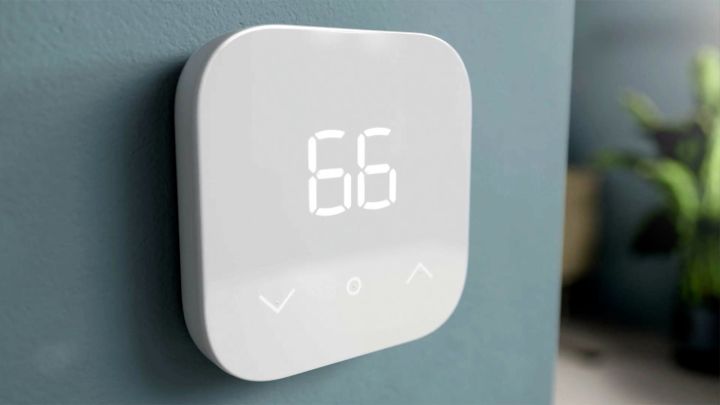Investing in a smart thermostat is one purchase you’ll never regret. A networked temperature control device means easy degree adjustments using your phone, tablet, or voice commands when at home. Who could say no to month-over-month energy savings? If you’ve been thinking about buying a smart thermostat, you may be familiar with some of the top names in the marketplace — from Nest to Ecobee. Now, there’s a new thermostat brand to be reckoned with (and it’s also one of the most affordable).
First unveiled at Amazon’s fall 2021 hardware event, the all-new Amazon Smart Thermostat is a $60 smart thermostat that Amazon co-developed with Resideo, the genius minds behind the Honeywell Home line of thermostats. With Alexa built right into the thermostat, homeowners can use the Alexa app to adjust the temperature on the go, set schedules, monitor energy efficiency, and more.
While the Smart Thermostat doesn’t hit shelves until November 4, there’s plenty to learn about this exciting new device. Here’s all the intel we’ve gathered.
Design and installation

Going with a sleek and minimalist (and slightly boxy) thermostat design, the Amazon Smart Thermostat measures 3.56-inches wide, 3.56-inches tall, and 0.84-inches from front to back. In terms of faceplate colors, the only shell shade available is white. The touchscreen portion of the thermostat keeps things simple, too. A majority of the thermostat’s face is taken up by the digital temperature display and has buttons below for temperature up/down and select/mode.
After unboxing, you can use the Alexa app to walk through a guided install of the Smart Thermostat. When it comes time to pair the thermostat to Wi-Fi, it’s important to know that the Smart Thermostat can only be connected to 2.4GHz Wi-Fi networks (not compatible with 5GHz bands). If you’re having trouble getting the thermostat connected, you can opt for the Amazon Home Services team to install the thermostat. Of course, you can always contact a local HVAC pro to do the job, too.
Smart Thermostat compatibility

Amazon claims that the Smart Thermostat will be compatible with most 24-volt HVAC systems. If you’re not sure if the device will interface with your home’s heating and cooling, there’s a handy compatibility checker right on the Smart Thermostat product page. The widget will ask a series of guided questions to determine what kind of wiring your HVAC system uses. If everything checks out in the end, Amazon will give you the go-ahead for integrating the Smart Thermostat with your home’s system. If it seems that the wiring or HVAC components in your house won’t mesh with the device, the widget informs you the Smart Thermostat probably won’t work.
Speaking of wiring: The Smart Thermostat requires a C-wire connection. Known as the common wire, this is the powered lead that provides consistent power to Wi-Fi-powered thermostats. If your HVAC system is fairly old, there’s a chance the system won’t have a common wire. Thankfully, there’s a pretty easy way to determine whether or not your HVAC has a C-wire.
First, turn off the circuit that your HVAC wiring is tied into. Then, pull the faceplate off of your existing thermostat. If there’s a lead connected to the C-labeled terminal, that’s the common wire connection. If there’s nothing connected to the C-terminal, look in the wall opening where the wires are fished up (or down) from your HVAC to the thermostat. Sometimes, if the system is old, the service team that installed the original gear may have run a C-wire as a means of future-proofing.
If there are no extra wires with a C-label hanging out in the stud bay, rest assured, you can still purchase the Smart Thermostat — you’ll just need to fork over 15 extra dollars. For systems with no C-wire, Amazon sells the thermostat with a handy C-wire adapter kit.
Month-over-month energy savings
Thanks in parts to its co-development with the Honeywell team, the Amazon Smart Thermostat is an Energy Star-certified product. Receiving this certification is no small merit, as an Energy Star laurel means that the thermostat you’ve purchased is required to save you at least $50 a year on your electric bill.
What’s even better is that when you factor in additional rebates from your energy provider, Amazon claims that, from an investment standpoint, the Smart Thermostat may cost you as little as $10 or nothing at all. To see what kind of incentives your home can qualify for, you can pop into the Energy Dashboard in the Alexa app.
Use Alexa Hunches for temperature control

One way Alexa helps manage our smart homes is through an integrated skill called Hunches. It’s a convenient feature for all Alexa product owners with one or more smart home devices. Alexa actively uses Hunches as a learning tool for you and your home. Here’s the tech in a nutshell:
Let’s say you crawl into bed at night and normally say “Alexa, goodnight” to your bedside Echo Dot. Once this Routine is initiated, Alexa will automatically draw the smart blinds downstairs and arm your smart security system. But what about the night where you forget to bid your smart assistant goodnight? If you typically use the “Alexa, goodnight” command before you hit the hay, with Hunches enabled, Alexa will know that you usually say goodnight to her. So, without you having to say anything, the voice assistant will lock up the house for the evening.
What does that mean for the Smart Thermostat? By observing your daily temperature habits (when you normally raise/lower the temperature, what temperature the thermostat is normally set to), Alexa uses Hunches to automatically adjust the temperature in a pinch — even if you’re not home.
Of course, you’ll still be able to use the Alexa app (and the thermostat) to manually adjust the temperature. If you’re not a fan of Alexa running the show on auto-pilot, you can toggle Hunches off in the Alexa app.
No speaker or mic means no voice commands

It seems that whenever a smart device has the Alexa label, it means you’ll be able to control the product using voice commands. While the Alexa name is all over the Smart Thermostat, there’s a catch: Yes, you can absolutely control the thermostat using voice commands, but the Smart Thermostat has no onboard speaker or microphone. So, you’ll need to have some kind of smart speaker or display around the house if you want to adjust the temperature using spoken phrases like “Alexa, set the temperature to 68-degrees.” If you don’t already own a smart speaker, display, or hub of some kind, there are several devices we can recommend — from the fantastic Amazon Echo speaker to the Echo Show 10 smart display.
If you’re not interested in purchasing a standalone device for voice commands, you can always speak commands to Alexa when you’re using the Alexa app (just make sure you’ve allowed Alexa access to your mobile device’s microphone).
Pricing and availability
The Amazon Smart Thermostat is available for pre-order now, but officially hits digital and brick-and-mortar shelves on November 4. There are two versions of the product for purchase: The Thermostat only ($60) and the Thermostat with C-Wire adapter ($75). The Amazon Smart Thermostat also comes with a one-year limited warranty.



